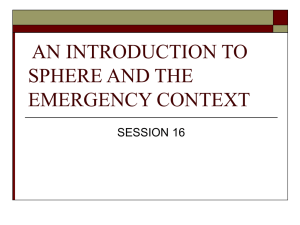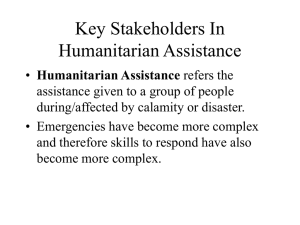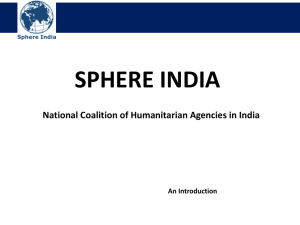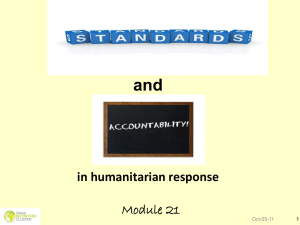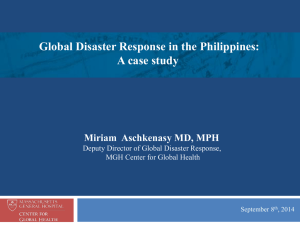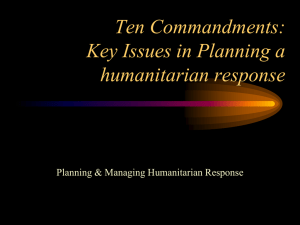Sphere Project. Speaker: Ms. Ginny Nagy
advertisement
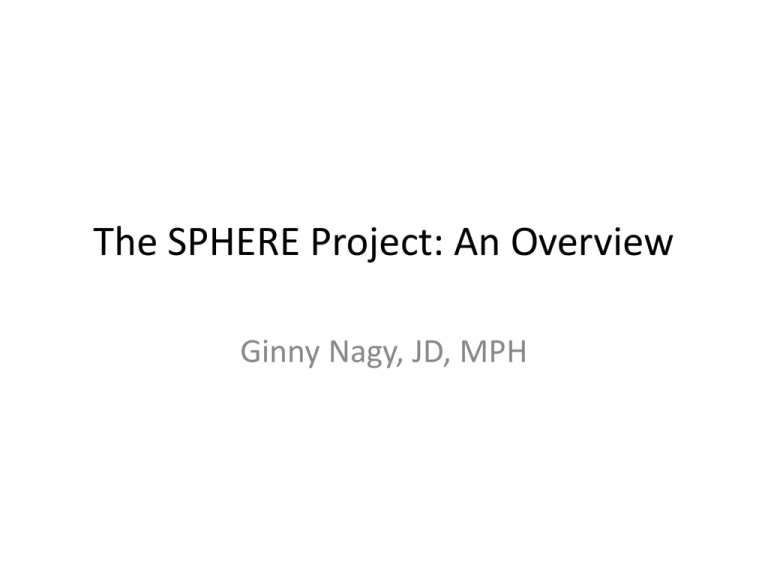
The SPHERE Project: An Overview Ginny Nagy, JD, MPH What is Sphere? The SPHERE Project is based on two core beliefs: 1. All possible steps should be taken to alleviate human suffering arising out of calamity and conflict; and 2. Those affected by disaster have a right to life with dignity and therefore a right to assistance. What is SPHERE? SPHERE is three things: 1. A Handbook; 2. A broad process of collaboration; and 3. An expression of commitment to quality and accountability. What is SPHERE? History of SPHERE • The initiative was launched in 1997 by a group of humanitarian NGOs and the Red Cross and Red Crescent movement, who framed a Humanitarian Charter and identified Minimum Standards to be attained in disaster assistance. This process led to the publication of the first SPHERE Handbook in 2000. • To date, over 400 organizations in 80 countries all around the world have contributed to the development of the Minimum Standards and key indicators. • Taken together, the Humanitarian Charter and the Minimum Standards contribute to an operational framework for accountability in disaster assistance efforts. SPHERE Humanitarian Charter • The cornerstone of the handbook is the Humanitarian Charter, which is based on the principles and provisions of international humanitarian law, international human rights law, refugee law and the Code of Conduct for the International Red Cross and Red Crescent Movement and Non Governmental Organizations (NGOs) in Disaster Relief. Humanitarian Charter Principles • The Right to life with dignity – The right to life, to an adequate standard of living and to freedom from cruel, in human or degrading treatment or punishment. • The distinction between combatants and noncombatants – Non-combatants are protected under international humanitarian law and are entitled to immunity from attack. 4/13/2015 Ghana National Government Pandemic Disaster Response Tabletop Exercise 7 Humanitarian Charter Principles • The principle of non-refoulement – This is the principle that no refugee shall be sent (back) to a country in which his or her life or freedom would be threatened on account of race, religion, nationality, membership of a particular social group or political opinion; or where there are substantial grounds for believing that s/he would be in danger of being subjected to torture. When to Use the SPHERE Handbook • The SPHERE handbook is designed for use in disaster response, and may also be useful in disaster preparedness and humanitarian advocacy. • It is applicable in a range of situations where relief is required, including natural disasters as well as armed conflict. • It is designed to be used in both slow- and rapid-onset situations, in both rural and urban environments, in developing and developed countries, anywhere in the world. • The emphasis throughout SPHERE is meeting the urgent survival needs of people affected by disaster, while asserting their basic human right to life with dignity. Limitations of the SPHERE Handbook • It is important to remember that the information contained in the handbook is neither prescriptive nor all-inclusive. • The handbook is not designed for use in response to technological disasters, such as those involving transport, industrial, chemical, biological or nuclear calamity. • However, while not addressing these types of disasters specifically, it is relevant to situations where population movements or other consequences triggered by such an event create a need for humanitarian assistance. Vulnerable Groups In order to maximize the coping strategies of those affected by disasters, it is important to acknowledge the differing vulnerabilities, needs and capacities of affected groups. The key vulnerable groups identified in the Handbook include: – Women; – Children; – Elderly; – Disabled; – People Living with HIV/AIDS; and – Ethnic minorities. Minimum Standards Minimum Standards Common to all Sectors • • • • • • • • • • • 1. Children 2. Elderly 3. Gender 4. HIV and AIDS 5. People with disabilities 6. Protection 7. Psycho-social 8. Climate change 9. Disaster risk reduction 10. The environment. Consider “AAAQ” (Acceptability, accessibility, acceptability, quality) Minimum Standards: Water, Sanitation and Hygiene Promotion This section is broken into six areas of focus: 1. 2. 3. 4. 5. Hygiene Promotion; Water Supply; Excreta Disposal; Vector Control; Solid Waste Management; and 6. Drainage. Minimum Standards: Food Security, Nutrition and Food Aid This section is divided into four areas of focus : 1. Food Security and Nutrition assessment and Analysis standards; 2. Food Security standards; 3. Nutrition standards; and 4. Food Aid standards. Minimum Standards: Shelter, Settlement and Non-Food Items This section is divided into two parts: 1. Shelter and Settlement; and 2. Non-Food Items (which includes clothing, bedding and household items). Both sections provide general standards for use in any of several response scenarios, such as the return to and repair of damaged dwellings, accommodation with host families, mass shelter in existing buildings and structures, and temporary, planned, or self-settled camps. Minimum Standards: Health Services This section is divided into three parts: 1. Health Systems and Infrastructure; 2. Control of Communicable Diseases; and 3. Control of Non-Communicable Diseases. Additionally, this section includes a Health Services Assessment Checklist, sample weekly surveillance forms and formulas for calculating rates of morbidity and mortality. In Summary • The SPHERE Humanitarian Charter and Minimum Standards will not solve all of the problems of humanitarian response, nor can they prevent all human suffering. • However, they can offer is a tool for humanitarian agencies to enhance the effectiveness and quality of their assistance, with the goal of making a significant difference in the lives of people affected by disaster. SPHERE References • SPHERE Project website: http://www.SPHEREproject.org • SPHERE Project Document database: http://www.SPHEREproject.org/component/option,com_doc man/task,cat_view/gid,70/Itemid,203/lang,english/ • International Federation of Red Cross and Red Crescent Societies: http://www.ifrc.org/
